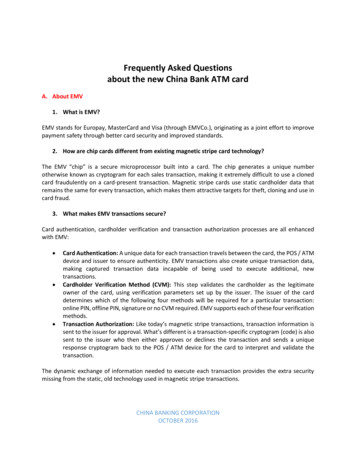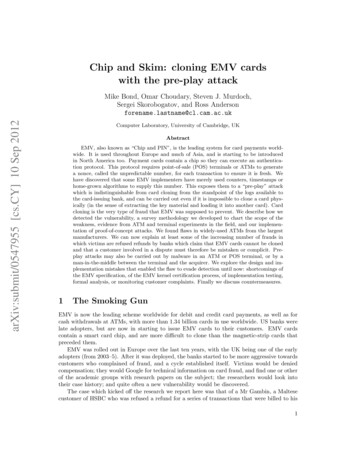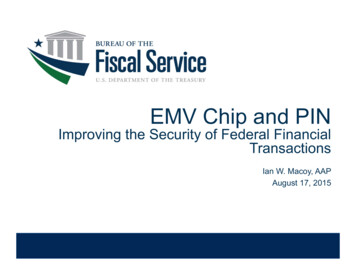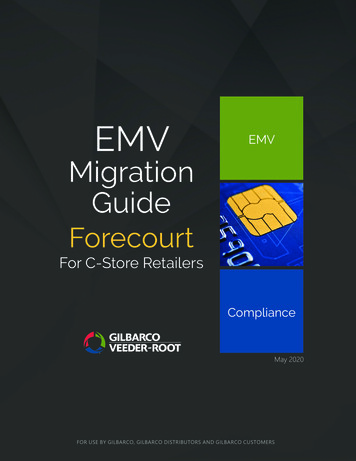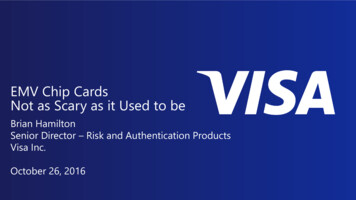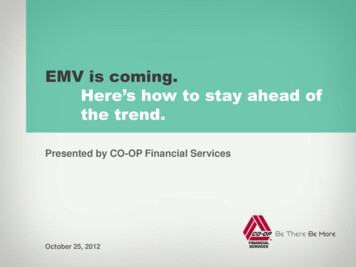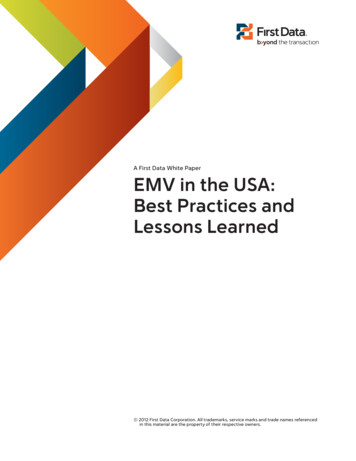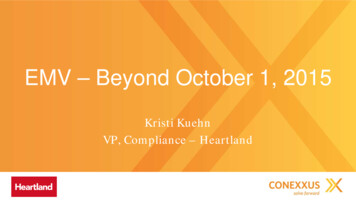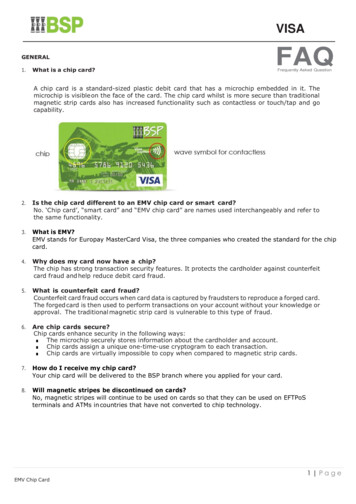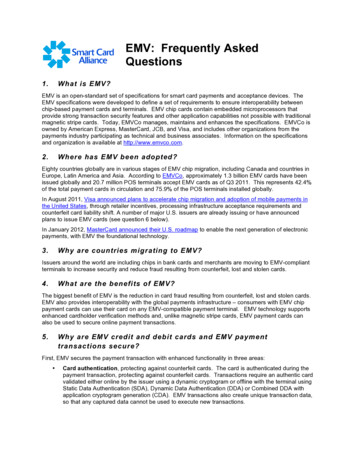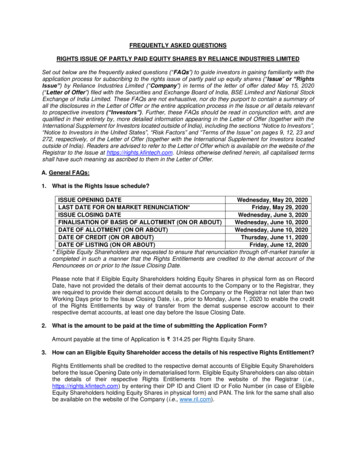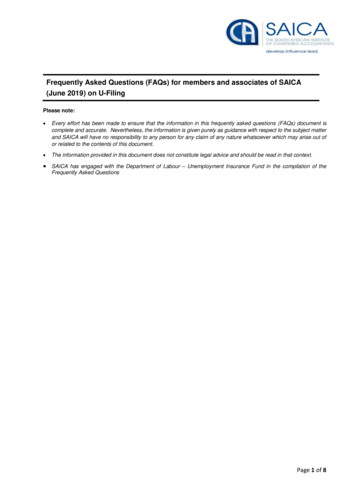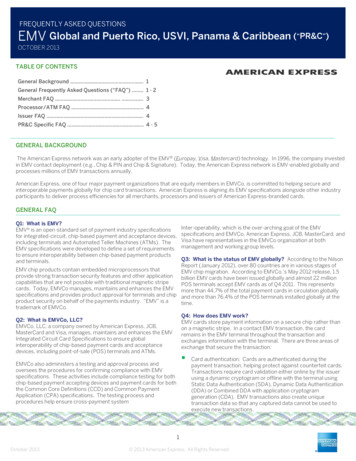
Transcription
FREQUENTLY ASKED QUESTIONSEMV Global and Puerto Rico, USVI, Panama & Caribbean (“PR&C”)OCTOBER 2013TABLE OF CONTENTSGeneral Background . . . .1General Frequently Asked Questions (“FAQ”) . . .1-2Merchant FAQ . . .3Processor/ATM FAQ . . . . .4Issuer FAQ . . . .4PR&C Specific FAQ . . .4-5GENERAL BACKGROUNDThe American Express network was an early adopter of the EMV (Europay, Visa, Mastercard) technology. In 1996, the company investedin EMV contact deployment (e.g., Chip & PIN and Chip & Signature). Today, the American Express network is EMV-enabled globally andprocesses millions of EMV transactions annually.American Express, one of four major payment organizations that are equity members in EMVCo, is committed to helping secure andinteroperable payments globally for chip card transactions. American Express is aligning its EMV specifications alongside other industryparticipants to deliver process efficiencies for all merchants, processors and issuers of American Express-branded cards.GENERAL FAQQ1: What is EMV?EMV is an open-standard set of payment industry specificationsfor integrated-circuit, chip-based payment and acceptance devices,including terminals and Automated Teller Machines (ATMs). TheEMV specifications were developed to define a set of requirementsto ensure interoperability between chip-based payment productsand terminals.Inter-operability, which is the over-arching goal of the EMVspecifications and EMVCo. American Express, JCB, MasterCard, andVisa have representatives in the EMVCo organization at bothmanagement and working group levels.Q3: What is the status of EMV globally? According to the NilsonReport (January 2012), over 80 countries are in various stages ofEMV chip products contain embedded microprocessors thatEMV chip migration. According to EMVCo.’s May 2012 release, 1.5provide strong transaction security features and other applicationbillion EMV cards have been issued globally and almost 22 millioncapabilities that are not possible with traditional magnetic stripePOS terminals accept EMV cards as of Q4 2011. This representscards. Today, EMVCo manages, maintains and enhances the EMV more than 44.7% of the total payment cards in circulation globallyspecifications and provides product approval for terminals and chip and more than 76.4% of the POS terminals installed globally at theproduct security on behalf of the payments industry. “EMV” is atime.trademark of EMVCo.Q4: How does EMV work?EMV cards store payment information on a secure chip rather thanon a magnetic stripe. In a contact EMV transaction, the cardremains in the EMV terminal throughout the transaction andexchanges information with the terminal. There are three areas ofexchange that secure the transaction:Q2: What is EMVCo, LLC?EMVCo, LLC, a company owned by American Express, JCB,MasterCard and Visa, manages, maintains and enhances the EMVIntegrated Circuit Card Specifications to ensure globalinteroperability of chip-based payment cards and acceptancedevices, including point-of-sale (POS) terminals and ATMs. EMVCo also administers a testing and approval process andoversees the procedures for confirming compliance with EMVspecifications. These activities include compliance testing for bothchip-based payment accepting devices and payment cards for boththe Common Core Definitions (CCD) and Common PaymentApplication (CPA) specifications. The testing process andprocedures help ensure cross-payment systemCard authentication: Cards are authenticated during thepayment transaction, helping protect against counterfeit cards.Transactions require card validation either online by the issuerusing a dynamic cryptogram or offline with the terminal usingStatic Data Authentication (SDA), Dynamic Data Authentication(DDA) or Combined DDA with application cryptogramgeneration (CDA). EMV transactions also create uniquetransaction data so that any captured data cannot be used toexecute new transactions.1October 2013 2013 American Express. All Rights Reserved.
FREQUENTLY ASKED QUESTIONSEMV Global and Puerto Rico, USVI, Panama & Caribbean (“PR&C”)OCTOBER 2013 Cardholder verification: Cardholder verification helps ensurethat the person attempting to make the transaction is the personto whom the card belongs. Cardholder verification methods(CVM) include Offline PIN, Online PIN, Signature and NoCardholder Verification Method for low dollar amounts.Secure EMV cards that perform dynamic data authentication haveproven effective in combating counterfeit fraud that occurs onmagnetic stripe cards in markets like the U.K.1 .EMV cards that havebeen enabled with a PIN provide added cardholder verificationprotection against fraud resulting from a lost or stolen card. Transaction authorization: The transaction is authorized eitheronline or offline. For online authorization, transactioninformation is sent to the issuer, along with a transaction-specificcryptogram, and the issuer either authorizes or declines thetransaction. For offline transactions, the card and terminalcommunicate and use issuer-defined risk parameters that aresent in the card to determine whether the transaction can beauthorized.The American Express network is EMV-enabled globally andprocesses millions of EMV transactions annually. Internationally,American Express has fraud liability shift rules and otherchargeback-related policies.Q5: What are DDA, CDA and SDA and how is American Expressusing them?The flow of data from an EMV card is encrypted to prevent it frombeing intercepted or manipulated in transit by unauthorized parties.There are three data authentication methods currently employed,each with differing levels of security. Static Data Authentication (SDA): Verifies that the EMV card’scontents match its digital signature. SDA will identify fraudulentEMV cards that have invalid numbers within its digital signature.SDA cannot identify counterfeit cards that have copied all of theoriginal card data. Dynamic Data Authentication (DDA): Verifies the EMV card’scontents and detects if the card has been copied or counterfeitedby forcing the card to correctly respond to a card-specific test.This authentication is believed to be more secure than SDA.American Express released a network mandate by which all newEMV card issuers must use DDA technology and authentication. Combined Dynamic Data Authentication (CDA): Similar to DDA,except that the terminal performs offline data authenticationwhile producing the application cryptogram. This combines thetwo processes and therefore delivers a higher level of securitythan is required of most applications.Q7: If EMV cards are more secure, why don’t all cards havechips in them?The move to EMV cards has evolved at a different pace throughoutthe world and requires investment in technology by both the issuerand merchant. While magnetic stripe cards are secure, EMV is aglobal standard that introduces more security features and willenable the future evolution of the global payment industry.Q8: What is the difference between Chip & PIN and Chip &Signature?Chip & Signature and Chip & PIN are based on the same EMV chipbased technology. The difference is in the Cardholder VerificationMethod (CVM). For Chip & Signature, the Cardmember signature isthe verification method. For Chip & PIN, a PIN is the verificationmethod, Chip & PIN and Chip & Signature both offer enhancedsecurity against counterfeiting compared to traditional magneticstrip-only Cards.The issuer decides whether to issue the Card as Chip & Signature orChip & PIN. The American Express network supports both. Themerchant terminal will indicate whether it is Chip & Signature or Chip& PIN and the steps that should follow as a result.Q9: What is the difference between EMV contact andcontactless cards?Contact EMV cards refer to either “Chip & PIN” or “Chip & Signature”cards. Both payment cards utilize microprocessor chips, whichsecurely store card data. The card is inserted into a terminal readerdesigned for chip cards.Q6: Will contact EMV help reduce fraud and chargebacks?Contact EMV chip-based payments are believed to reduce fraudfrom counterfeit, lost or stolen cards and potentially the number ofchargebacks.Contactless –enabled cards allow transactions to be initiated bytapping or waving the card in front of a contactless reader at thepoint-of-sale. The contactless payment device can be a card,bracelet, key fob or smart phone. Card account and securityinformation is then sent wirelessly, using radio frequency, from thecontactless device to the reader. Both contactless cards andcontactless readers contain tiny antennae that allow datacommunication to take place. The device never leaves thepossession of the customer which enhances security and speeds upthe electronic transaction process.Similar to other chip-based payments, the dynamic chip datagenerated by EMV chip-based contact and contactless transactionsprovide both cardholders and merchants with enhanced security atthe point-of-sale.1 First Data, EMV in the U.S.: Putting it into Perspective for Merchants and FinancialInstitutions, 20112October 2013 2013 American Express. All Rights Reserved.
FREQUENTLY ASKED QUESTIONSEMV Global and Puerto Rico, USVI, Panama & Caribbean (“PR&C”)OCTOBER 2013Q10: What is the difference between magnetic stripe and EMV?ItemMagnetic Stripe CardEMV CardData StorageHolds basic cardholder informationHolds cardholder information and additional data securelyCardholderVerificationCan be vulnerable to counterfeit, lost orstolen or card-not-present fraud asmagnetic stripe can be copiedMore secure for card present fraud as an EMV card isdifficult to copy and transaction is interactive betweenchip and terminalEMV cards enabled with PIN offer additional protectionagainst fraud resulting from lost or stolen cardsUtilityFacilitates standard paymenttransactionsIn the future, may also facilitate additional payment andnon-payment applications (e.g., loyalty programs)MERCHANT FAQQ11: What are the benefits of EMV for merchants?Deploying EMV contact chip technology for payments can help youoptimize your business operations by delivering: Potential reduction in fraud-related expenses due to fewerdisputed transactions made with American Express-brandedcardsExpanded interoperability as you will be able to accept EMVcards from around the globe and from other payment brandsIncreased confidence for consumers who feel more secure withtheir transactionsQ12: What is the cost to migrate to EMV?Costs associated with migration to EMV vary greatly by merchant.Some of the variables influencing the costs include which terminalsare chosen; the level of external support required; and the tasks thathave to be completed to integrate EMV into the merchant networkand the point-of-sale (POS).We strongly recommend that you include American Express EMVcompliant software within your point of sale upgrade plans.Q14: If terminals can accept EMV transactions, are they alsoable to accept mobile or contactless transactions?EMV terminals can accept mobile or contactless transactionssubject to the POS hardware and software being used. It is themerchant’s decision whether to accept contactless and mobiletransactions as part of the EMV terminal upgrade. If you do, youwill need to make sure the EMV terminal upgrade includes themobile and/or contactless capabilities and is able to support thelatest American Express specifications.Q15: What is Fraud Liability Shift and how does it apply toEMV?Fraud Liability Shift (FLS) is used to encourage the adoption offraud mitigation technologies, such as EMV.For EMV, FLS transfers liability for certain types of fraudulenttransactions away from the party that has the most secure form ofEMV technology. The decision to implement FLS is made by eachpayment brand individually, on a country-by-country basis.Q13: What is the certification process and requirements tomove to EMV?Per EMVCo., each card brand requires end to end certification. Toget more information about how American Express and EMV in yourregion, contact your American Express representative. If you areusing a third-party processor to authorize and submit cardtransactions, you will need to work with your processor to get moredetails about the certification process. If you authorize or submitcard transactions directly to American Express, please contact yourAmerican Express representative.3October 2013 2013 American Express. All Rights Reserved.
FREQUENTLY ASKED QUESTIONSEMV Global and Puerto Rico, USVI, Panama & Caribbean (“PR&C”)OCTOBER 2013PROCESSOR/ATM PROCESSOR FAQQ16: What are processors and ATM processors required to doto support EMV?All processors are required to certify their infrastructure to supportAmerican Express EMV chip-based contact, contactless and mobiletransactions.Q17: What are the American Express certification requirementsfor EMV?American Express requires EMV host certification and end to endcertification for every terminal/reader model and/or uniqueconfiguration. For further details, please contact your AmericanExpress Representative.Q18: What does an ATM owner need to do to support EMV?To support EMV, an ATM owner may need to upgrade their ATMhardware and/or software, including the deployment of contactand contactless reader hardware. The ATM owner will need tocoordinate the ATM hardware and/or software upgrade with theirprocessor to ensure EMV certification has been completed.Q21: Does American Express offer non-financial support toissuers to expedite the migration to EMV cards?Yes, American Express provides an “On Behalf Of” cryptogramvalidation service for EMV card transactions. This enablesparticipants to take advantage of EMV without the costs associatedwith building cryptogram validation logic on the issuer’sauthorization host system. For issuers using this capability,American Express will validate the cryptogram on the issuer’sbehalf and forward an incoming authorization message to theissuer for decisioning with a flag indicating whether the cryptogramwas successfully validated.ISSUER FAQQ19: Do issuers need to complete any certification on theAmerican Express card issuance infrastructure to support EMVissuance?Yes. Issuers should contact their American Express representativeto review the engagement process and certification requirements forthe issuer’s chip products.PUERTO RICO, USVI, PANAMA & CARIBBEAN (PR&C) SPECIFIC FAQQ20: How long does it generally take for card-issuingpartners to complete an EMV migration?Migrating to EMV is a complex project that will impact issuing andacquiring infrastructures as well as back-end authorizationsystems. As the scope of each issuer implementation could vary,an exact estimate is difficult to provide; however, for planningpurposes, an issuer should plan for an approximate 6-9 monthtimeframe to complete an EMV migration.Q23: What does American Express’ EMV roadmap in PR&Clook like?American Express will work alongside other industry participantsto encourage interoperability across PR&C and other countries andsupport chip-based technology for chip & PIN, chip & Signature,contactless and mobile transactions. The company’s key policyrequirement and date for PR&C is:Q22: What is American Express’ position on EMV in PR&C?PR&C remains in the early stages of adoption, and we believe thatAmerican Express is entering at the right time to contribute toindustry plans and advance EMV adoption.The American Express network was an early adopter of EMVtechnology and is committed to helping secure and interoperablepayments globally for EMV card transactions. Today, the AmericanExpress network is EMV-enabled globally and processes millions ofEMV transactions annually. By April 2014, processors must be able to support AmericanExpress EMV chip-based contact transactions.By April 2015, processors must be able to support AmericanExpress EMV chip-based contactless transactions.Effective October 2015, American Express will institute a FraudLiability Shift (FLS) policy that will transfer liability for certaintypes of fraudulent transactions away from the party that hasthe most secure form of EMV technology. Fuel merchants willhave an additional two years, until October 2017, before the FLStakes effect for transactions generated from automated fueldispensers.4October 2013 2013 American Express. All Rights Reserved.
FREQUENTLY ASKED QUESTIONSEMV Global and Puerto Rico, USVI, Panama & Caribbean (“PR&C”)OCTOBER 2013Q24: Will American Express support all types of CardholderVerification Methods (CVMs)?Yes, the American Express network specifications support all EMVrecognized methods of cardholder verification, including Offline PIN,Online PIN, Signature and No CVM for low dollar amounts,regardless of the issuer’s EMV product presented by theCardmember at the point-of-sale. The cardholder verificationmethod that is used at the point-of-sale will depend on the cardproduct, terminal capabilities and transaction value.Q25: What is the merchant demand for EMV-enabled terminalsin PR&C?In the past year, American Express has seen an increase in merchantrequests for EMV-enabled terminals in PR&C. EMV technologyoffers enhanced security and the potential for reduced applicablecard fraud. Merchant terminals typically require both hardware (toread the EMV contact and contactless chips) and American Expresscompliant? EMV software to read and interact with the chip andprocess incremental chip data generated. Once merchants loadtheir terminals with American Express compliant software,merchants will be required to certify their devices with AmericanExpress, if their processor has not already done so, to confirmconformance with our requirements.Q26: What is your fraud liability shift policy in PR&C? Is this afinancial incentive for merchants?Effective October 2015, American Express will institute a FraudLiability Shift (FLS) policy that will transfer liability for certain typesof fraudulent transactions away from the party that has the mostsecure form of EMV technology. Fuel merchants will have anadditional two years, until October 2017, before the FLS takes effectfor transactions generated from automated fuel dispensers.Following the rollout of EMV in other countries, merchants have seena reduction in certain types of fraud and fraud chargebacks. It isexpected that merchants will experience similar reductions in PR&C.This reduction of fraud and chargebacks can result in a beneficialreturn on EMV-related investments by merchants and issuers.Q27: What are the consequences for merchants in PR&C fornon-compliance for EMV transactions?Effective October 2015, American Express will institute a FraudLiability Shift (FLS) policy to transfer liability for certain types offraudulent transactions away from the party that has the mostsecure EMV technology. Fuel merchants will have an additional twoyears, until October 2017, before the FLS takes effect fortransactions generated from automated fuel dispensers.A merchant could be subjected to increased fraud exposure forfailing to adopt EMV technology.American Express is dedicated to ensuring all parties embrace apolicy that supports secure processing of Card Member dataQ28: When will changes be made to American Express’ PR&CMerchant Regulations?The American Express Merchant Regulations – PR&C will beupdated prior to the October 2015 Fraud Liability Shift (FLS)effective dates.Q29: Will ATMs in PR&C that accept American Express Cardsalso accept EMV chip-based cards?American Express expects that over time ATM owners in PR&C willdeploy ATMs that accept contact and contactless EMV cards.American Express will be working with ATM owners and theirprocessors to ensure ATMS are enabled to process transactionsmade with American Express-branded EMV cards as EMVtransactions.5October 2013 2013 American Express. All Rights Reserved.
Method (CVM). For Chip & Signature, the Cardmember signature is the verification method. For Chip & PIN, a PIN is the verification method, Chip & PIN and Chip & Signature both offer enhanced security against counterfeiting compared to traditional magnetic strip-only Cards. The issuer decides whether to issue the Card as Chip & Signature or Chip .
